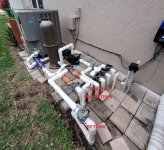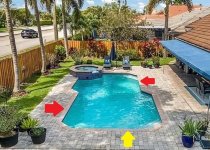Appreciate the pics. Helps a little in this discussion. Have you confirmed that any apparent water loss isn't actually water moving back & forth between the pool and spa? Other than the spa (I don't have one) our systems are similar. You have multiple locations where someone could insert a pressure test manifold to pressurize the line for testing. This would at least confirm a break in the line somewhere. Pinpointing it is done with listening devices (deck plate, sound rod, etc). Since you only have one return jet line leaving the pad, we know that line later splits to 3 different return jets, so as James noted, even if water actually is getting pulled into the opening, there's no way to know exactly where the dye is going from there.
I recently battelled this issue, so I know the frustrations associated with a potential leak. Below are a couple of my threads to give you an idea of what to expect.
After several months of debate and testing that has confirmed I have plumbing leak on both the pressure and suction sides, I've finally decided to go in. My priority is the suction line right now since I have a Frakenplug installed in my cracked return jet, but since I had to rent a concrete...

www.troublefreepool.com
After 9 years it finally happened – the dreaded leak. Here is my story. In the San Antonio area we have black clay soil that is horrible for structural support of any kind and often causes problems for home foundations, fencing, asphalt, pools, etc. When we observed excessive water loss, I...

www.troublefreepool.com



